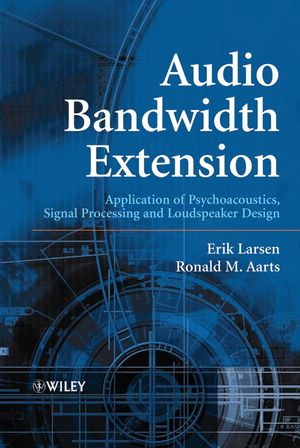Audio Bandwidth Extension: Application of Psychoacoustics, Signal Processing and Loudspeaker DesignISBN: 978-0-470-85864-6
Hardcover
312 pages
October 2004
 This is a Print-on-Demand title. It will be printed specifically to fill your order. Please allow an additional 15-20 days delivery time. The book is not returnable.
|
||||||
I Introduction.
I.1 Bandwidth Defined.
I.2 Historic Overview.
I.2.1 Electroacoustic Transducers.
I.2.2 Sound Quality.
I.3 Bandwidth Extension Framework.
I.3.1 Introduction.
I.3.2 The Framework.
1 From Physics to Psychophysics.
1.1 Signal Theory.
1.1.1 Linear and Non-linear Systems.
1.1.2 Continuous-time LTI (LTC) Systems.
1.1.3 Discrete-time LTI (LTD) Systems.
1.1.4 Other Properties of LTI Systems.
1.1.5 Digital Filters.
1.2 Statistics of Audio Signals.
1.2.1 Speech.
1.2.2 Music.
1.3 Loudspeakers.
1.3.1 Introduction to Acoustics.
1.3.2 Loudspeakers.
1.3.3 Bessel and Struve Functions.
1.4 Auditory Perception.
1.4.1 Physical Characteristics of the Peripheral Hearing System.
1.4.2 Non-linearity of the Basilar Membrane Response.
1.4.3 Frequency Selectivity and Auditory Filters.
1.4.4 Loudness and Masking.
1.4.5 Pitch.
1.4.6 Timbre.
1.4.7 Auditory Scene Analysis.
1.4.8 Perceptual Modelling – Auditory Image Model.
2 Psychoacoustic Bandwidth Extension for Low Frequencies.
2.1 Introduction.
2.2 Psychoacoustic Effects for Low-frequency Enhancement of Small Loudspeaker Reproduction.
2.2.1 Pitch (Harmonic Structure).
2.2.2 Timbre (Spectral Envelope).
2.2.3 Loudness (Amplitude) and Tone Duration.
2.3 Low-Frequency Psychoacoustic Bandwidth Extension Algorithms.
2.3.1 Overview.
2.3.2 Non-Linear Device.
2.3.3 Filtering.
2.3.4 Gain of Harmonics Signal.
2.4 Low-Frequency Psychoacoustic Bandwidth Extension with Frequency Tracking.
2.4.1 Non-Linear Device.
2.4.2 Frequency Tracking.
2.5 Subjective Performance of Low-Frequency Psychoacoustic Bandwidth Extension Algorithms.
2.5.1 ‘Virtual Bass’.
2.5.2 ‘Ultra Bass’.
2.6 Spectral Characteristics of Non-Linear Devices.
2.6.1 Output Spectrum of a Rectifier.
2.6.2 Output Spectrum of Integrator.
2.6.3 Output Spectra in Discrete Time.
2.6.4 Output Spectrum of Clipper.
3 Low-frequency Physical Bandwidth Extension.
3.1 Introduction.
3.2 Perceptual Considerations.
3.2.1 Pitch (Spectral Fine Structure).
3.2.2 Timbre (Spectral Envelope).
3.2.3 Loudness (Amplitude).
3.3 Low-frequency Physical Bandwidth Extension Algorithms.
3.3.1 Systems with Low-frequency Extension.
3.3.2 Non-linear Device.
3.3.3 Filtering.
3.3.4 Gain of Harmonics Signal.
3.4 Low-frequency Physical Bandwidth Extension Combined with Low-frequency Psychoacoustic Bandwidth Extension.
4 Special Loudspeaker Drivers for Low-frequency Bandwidth Extension.
4.1 The Force Factor.
4.2 High Force Factor Drivers.
4.3 Low Force Factor Drivers.
4.3.1 Optimal Force Factor.
4.4 Transient Response.
4.4.1 Gated Sinusoid Response.
4.4.2 Impulse Response.
4.5 Details of Lumped-element Parameters and Efficiency.
4.6 Discussion.
5 High-frequency Bandwidth Extension for Audio.
5.1 Introduction.
5.2 The Limits of Deconvolution.
5.3 Perceptual Considerations.
5.3.1 Pitch (Harmonic Structure).
5.3.2 Timbre (Spectral Envelope).
5.3.3 Loudness (Amplitude).
5.3.4 Effects of Hearing Loss.
5.3.5 Conclusions.
5.4 High-frequency Bandwidth Extension for Audio.
5.4.1 Non-linear Device.
5.4.2 Filtering.
5.4.3 Gain of Harmonics Signal.
5.5 Spectral Band Replication (SBR).
5.6 High-frequency Bandwidth Extension by Instantaneous Compression.
5.6.1 Introduction and Algorithm.
5.6.2 Analysis of Harmonics Generation.
5.6.3 Implementation.
5.6.4 Examples.
5.6.5 Approximation of the Function tanh(Z).
6 Bandwidth Extension for Speech.
6.1 Applications.
6.2 From a Speech Production Model to the Bandwidth Extension Algorithm.
6.2.1 Model of the Process of Speech Production.
6.2.2 Bandwidth Extension Algorithm.
6.2.3 Alternative Structures.
6.3 Extension of the Excitation Signal.
6.3.1 Explicit Signal Generation.
6.3.2 Non-linear Processing.
6.3.3 Modulation in the Time Domain.
6.3.4 Pitch Scaling.
6.3.5 Discussion.
6.4 Estimation of the Wideband Spectral Envelope.
6.4.1 Representations of the Estimated Spectral Envelope.
6.4.2 Instrumental Performance Measure.
6.4.3 Theoretical Performance Bound.
6.5 Feature Selection.
6.5.1 Mutual Information.
6.5.2 Separability.
6.5.3 Linear Discriminant Analysis.
6.5.4 Primary Features.
6.5.5 Evaluation.
6.6 Codebook Mapping.
6.6.1 Vector Quantization and Training of the Primary Codebook.
6.6.2 Training of the Shadow Codebook.
6.7 Linear Mapping.
6.7.1 Training Procedure.
6.7.2 Piecewise-linear Mapping.
6.8 Gaussian Mixture Model.
6.8.1 Minimum Mean Square Error Estimation.
6.8.2 Training by the Expectation-maximization Algorithm.
6.9 Hidden Markov Model.
6.9.1 Statistical Model of the Markov States.
6.9.2 Estimation Rules.
6.10 Discussion.
7 Noise Abatement.
7.1 A Special Kind of Noise Reduction.
7.2 The Noise Pollution Problem – Case Study.
7.3 The Application Low-frequency Psychoacoustic Bandwidth Extension to Noise Pollution.
8 Bandwidth Extension Patent Overview.
Appendix A Multidimensional Scaling.
A.1 Introduction.
A.2 Scaling.
A.3 Example.
A.4 Procedure.
A.5 Precautions Concerning the Solution.
A.6 Significance of Stress.
A.7 Univariate Scaling.
References.
Index.



